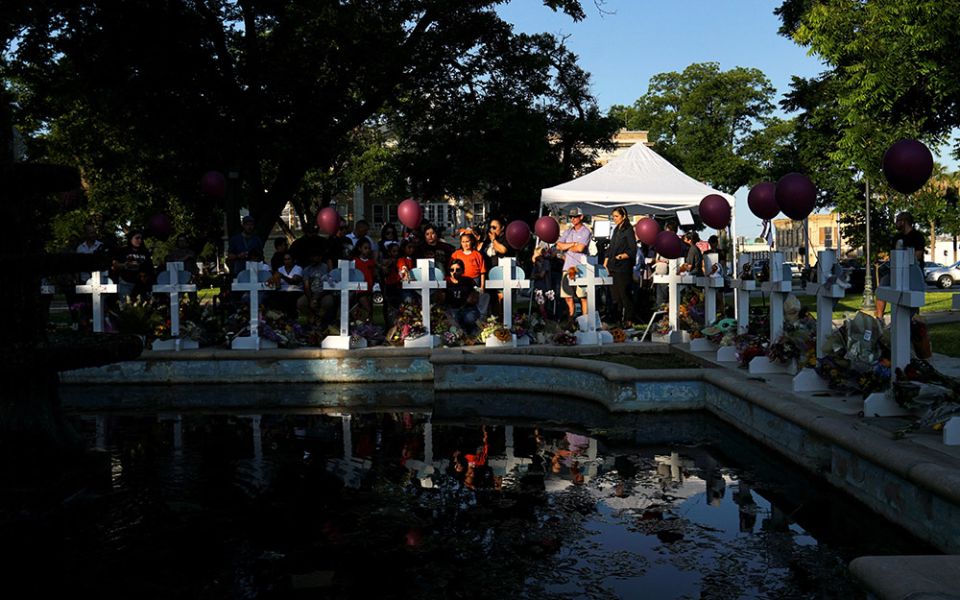Trauma is Real
Let’s Build a Better Society
Superb article from the Catholic press.
Stop Worshiping the Second Amendment and Stand Up for Human Life!
It’s Time to Be Honest About Guns as a LIFE ISSUE
REAL Life Issues vs. Rhetoric
This wonderful article has to be shared widely!
A Sad State of Affairs
Sadly, our most brilliant and pastoral American Bishops are overshadowed by obsessive powermongers who delight in throwing gasoline on the Culture War fires. So…not only are American citizens a global laughingstock because of the imbecility of Donald Trump, but American Roman Catholics are derided because of the influence of these bishops. This is why I awaken each morning and pray “Merciful and Loving God, give me the strength to do this for one more day.”
https://www.ncronline.org/news/opinion/editorial-why-we-support-bishops-plan-deny-communion-bideneny-communion-biden
The Truth in Our History: Both Genders are called to serve
Jesus founded a movement led by both women and men
Sometimes it is really difficult to be both female and Catholic.
On the one hand, I couldn’t be prouder of the creative leadership taken by the University of Notre Dame and Pope Francis in working with oil executives to address climate change. It is amazing that dozens of Catholic institutions, including Caritas Internationalis, have divested from fossil fuels.
On the other hand, I am dismayed by yet another statement from the Vatican — this time from Cardinal-designate Luis Ladaria — prefect of the Congregation for the Doctrine of the Faith — about the non-ordination of women to the priesthood.
FEATURED SERIES:
Explore this NCR special report with recent articles on the topic of immigration and family separation.
I have been tracking Vatican statements on women priests since the 1970s. They are invariably ahistorical and biblically naive. It is embarrassing. Worse, they bear false witness to the Jesus of history and are ultimately destructive to the body of Christ, especially the distaff side.
As a contribution to the ongoing conversation about women’s roles in our church, I present here a few examples from mainstream scholarship about Jesus and the female exercise of authority in early Christianity.
Consider this from Ladaria’s statement: “Christ willed to confer this sacrament on the 12 apostles — all men — who, in turn, communicated it to other men. The church always has seen itself as bound to this decision of the Lord, which excludes that the ministerial priesthood can be conferred validly on women.”
Biblical scholars have long known that Jesus did not intend to found a new church led by 12 men, but to reform his own Judaic tradition. As such, the Twelve were meant to represent the new 12 tribes of Israel. They were not called to offer animal sacrifice at the Jerusalem Temple, as priesthood was understood in Jesus’ day.
That Jesus included women in his itinerant Galilean discipleship is undisputed. Luke 8:1-3 tells us that Mary of Magdala, Joanna, Susanna “and many other women” accompanied him around Galilee. With Mary and Elizabeth, women were present and active in Jesus’ life and ministry from womb to empty tomb. With Mary of Magdala, they were the first to proclaim the good news of Jesus’ resurrection-victory over the powers of death.
From the first century, we see a repeating pattern of women exercising ecclesial authority in the growth of early Christianity:
- Women founded and led house church communities (Lydia, Prisca, Nympha, Mary of Jerusalem, Tabitha);
- Prophesied (Philip’s daughters, Corinthian women);
- Taught male evangelists (Prisca);
- Functioned as apostles (Junia, Mary of Magdala), benefactors and envoys (Phoebe);
- Probably led communities in Philippi as episcopoi and diaconoi (Euodia and Syntyche). (It should be noted that episcopoi and diakonoi cannot simply be translated as “bishops” and “deacons” as we understand these church offices today. The titles do, however, indicate an important leadership function.)
Paul’s letters are the earliest historical documents we have. From him, we learn more about the title “apostle.” Writing between A.D. 40 and 60, Paul uses the word “apostle” inclusively to describe his own mission to the gentiles as well as that of other missionaries. In Romans 16:7, he calls Andronicus and Junia (a married missionary couple) “prominent among the apostles.”
Twenty years later, after the fall of Jerusalem (A.D. 80-85), Luke’s Gospel and the Acts of the Apostles reflect a growing struggle over who may exercise authority in the early church. Luke names three requirements for replacing the apostle Judas:
“Therefore, it is necessary to choose one of the men who have been with us the whole time the Lord Jesus was living among us, beginning from John’s baptism to the time when Jesus was taken up from us. For one of these must become a witness with us of his resurrection” (Acts 1:21-22).
Luke’s new criteria stipulate that apostles must be male, part of Jesus’ original discipleship, and eyewitnesses to the Resurrection. They guarantee that the individual title of apostle will die out as the original witnesses die.
Further, prominent leaders such as Paul, Mary of Magdala, James of Jerusalem, Junia and Andronicus no longer qualify as “apostles.” Ironically, third- and fourth-century churchmen will claim the authority of the apostles in imposing new church orders that exclude women from leadership.
Sadly, the practice continues to the present day.
Yet archaeologists and church historians point to gender balance in the exercise of authority in the early communities. For example, “ordination” as a “presbyter” (as priests were called at the time) did not take shape until long after Jesus’ death and resurrection. And there is compelling literary and inscriptional evidence that in the fourth and fifth centuries, women held presbyteral titles. These early presbyters were the precursors of today’s priests, and the evidence suggests that in some early communities both women and men functioned in these roles.
Ladaria’s contention that a male-only priesthood belongs to the “substance of the sacrament” and cannot be changed because Christ instituted the sacrament is another example of the ahistorical nature of current Vatican formulations.
The Christian understanding of sacrament did not become part of church teaching until the Middle Ages. It is the product of later reflection by exclusively male members of the body of Christ. This is not to say that sacraments are not a central part of Catholic teaching, as well as a beautiful way of describing the action of God in our lives. It is to say that this theological construct did not have the benefit of the Spirit-guided insights of the female members of Christ’s body.
It is perhaps for this reason that Cardinal Christoph Schönborn, in an Easter interview with the Austrian publication Die Presse, called for a new council to discuss the matter :
One of the key questions is the role of women in the church. In this, religious organizations as a whole are in need of development. … The question of ordination is a question that surely can only be settled by a council. A pope cannot decide this by himself. This is too large a question for it to be settled from the desk of a pope.
If Pope Francis can convene an international meeting of leaders to counter global warming, surely he can convene an international gender-balanced council to address the sexism and misogyny that have plagued our church for millennia.
[St. Joseph Sr. Christine Schenk served urban families for 18 years as a nurse midwife before co-founding FutureChurch, where she served for 23 years. She holds master’s degrees in nursing and theology.]
Thomas Reese Says It Better Than I Could!
Irish vote shows need for new pro-life strategy


(RNS) — The overwhelming vote in Ireland in favor of allowing access to abortion shows that the pro-life movement needs a new strategy. Trying to preserve anti-abortion laws or trying to reverse the legalization of abortion is simply not working.
In almost every country where abortion has been on the ballot, abortion has won. Rarely have pro-choice laws been reversed. This trend is not going to change. To think otherwise is simply ignoring reality.
The American pro-life movement still holds out hope that the U.S. Supreme Court will reverse Roe v. Wade, but even if that does happen, most Americans will still live in states where abortion is legal. Those who don’t will be able to travel to a state where it is, just as Irish women have long traveled to Britain.
The reality is that most Americans think that abortion should be legal even if they think it is immoral. There is no indication that this thinking will change. In fact, opinion is moving in the opposite direction, thanks to the attitudes of younger generations. The Pew Research Center shows Americans under 50 are more likely than their elders to support abortion in all or most cases. Likewise, in Ireland, younger people voted more strongly to change the law. Time is on the side of the pro-choice movement.
If making abortion illegal is an impossible goal, what should be the pro-life strategy for the foreseeable future?
The answer is simple and obvious: Work to reduce the number of abortions.
When women are asked why they are having an abortion, the main reasons given are that having a baby would interfere with their education, their work or their ability to care for the children they are already raising, or that they simply cannot afford another child at the time.
Pro-life activists must take these reasons into consideration when developing a new strategy.
Pro-life advocates should strongly support programs that give women a real choice — increasing the minimum wage, free or affordable day care for working and student moms, free or affordable health care for mothers and their children, parental leave programs, education and job-training programs, income and food supplements, etc.
In short, the pro-life movement must support any program that lessens the burden on mothers and their children.
No longer should Republicans be allowed to call themselves pro-life if they vote down programs that would help mothers and their children. In the early 1990s, Republicans in the New Jersey Legislature voted not to increase benefits for women on welfare if they have additional children. Thus, a mother with two children would have to take care of three with no increase in support. The consequences were quick and predictable: an increase in the number of abortions among women on welfare.
If abortion is never going to be illegal, pro-lifers must consider voting for candidates, even pro-choice Democrats, who will reduce the number of abortions by supporting programs that help mothers and their children. It is no accident that the number of abortions went down during the two most recent Democratic administrations, according to the CDC. (Clinton: 1,330,414 abortions in 1993 to 857,457 in 2000; Obama: 789,217 in 2009 to 652,639 in 2014).
Pro-life voters must choose between Republican rhetoric and Democratic results.
Churches must also step up. In today’s world, an unwed woman willing to give birth should be treated as a hero, not a whore. She is not the only unmarried woman in her age group who got pregnant, let alone the only person having sex. Yet, she is the one brave enough to choose life. Shame on the Pharisees who try to shame her.
Schools, too, must do more to help these women. Universities today talk much about diversity, but one of the most underrepresented groups on campuses is single mothers. Universities, especially Catholic universities, must design programs and housing to meet their needs. Such programs would benefit not only the mothers and their children but also other students. Perhaps they’d learn that “it takes a dorm to raise a child.”
Besides supporting programs to help mothers and children, the pro-life movement also has to support birth control as a means of avoiding unwanted pregnancies. Planned pregnancies do not get aborted; many unplanned pregnancies do.
Those who consider artificial contraception to be wrong must also recognize that abortion is a greater evil. When forced to choose, one must choose the lesser of two evils.
The contraceptive mandate of the Obama administration will do more to reduce the number of abortions than all of the legislative gimmicks of Republican legislators. If European Catholic institutions can pay money into national health programs that perform abortions, then American Catholic employers can pay for insurance programs that pay for birth control.
And while I would be happy to see Planned Parenthood put out of business, closing clinics that provide health care and birth control to women before replacements are up and running is irresponsible and counterproductive.
The goal of supporting mothers and children and decreasing the number of unplanned pregnancies should receive bipartisan support. While many people doubtless support these programs as ends in themselves, there is no reason the pro-life movement should not support them as means of reducing abortions.
The number of abortions in the United States peaked in 1990 at 1,429,247. Working together, we could reasonably get abortions down to under 100,000 per year — far too many, but an achievable goal and better than where we are today.
SUBVERT THE DOMINANT PARADIGM!
In Memory of Louise Akers, SC…
A mover and shaker of great faith



Check out Future Church for more…


